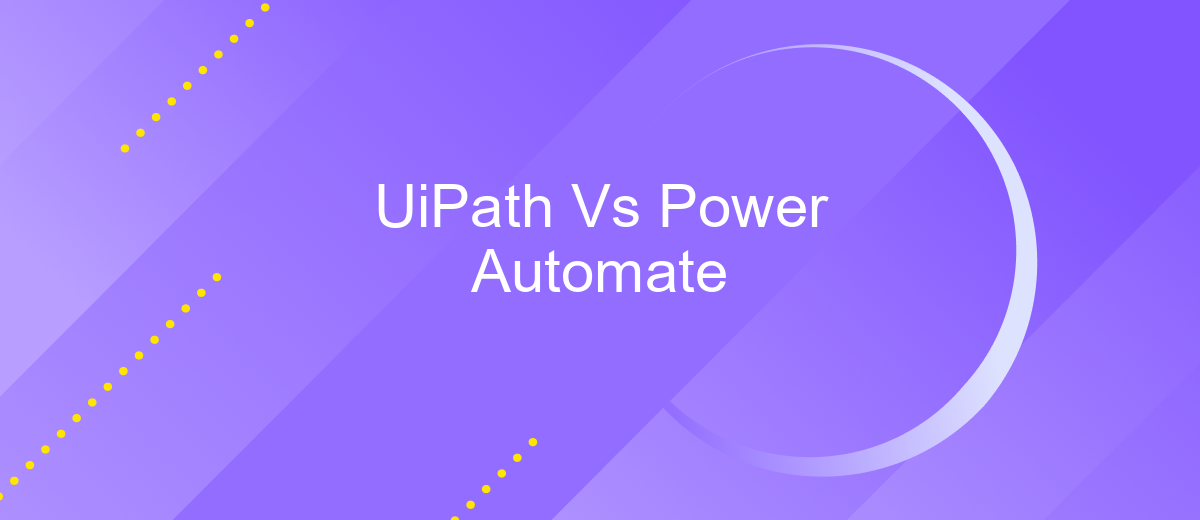UiPath Vs Power Automate
When it comes to automating business processes, UiPath and Power Automate stand out as two of the most popular tools in the market. Both offer unique features and capabilities that cater to different organizational needs. This article delves into a comparative analysis of UiPath and Power Automate, highlighting their strengths, weaknesses, and ideal use cases to help you make an informed decision.
Introduction
In today's digital era, automation tools have become indispensable for streamlining business processes. Two prominent players in this field are UiPath and Power Automate. Both platforms offer robust features to automate repetitive tasks, enhance productivity, and reduce human error. However, choosing the right tool for your organization can be challenging.
- UiPath is renowned for its advanced robotic process automation (RPA) capabilities, enabling businesses to automate complex workflows with ease.
- Power Automate, part of the Microsoft Power Platform, integrates seamlessly with other Microsoft services, offering a user-friendly experience for automating everyday tasks.
- Both tools support a wide range of integrations, including third-party services like ApiX-Drive, which facilitates seamless data transfer between applications.
This article aims to provide a comprehensive comparison between UiPath and Power Automate, highlighting their features, benefits, and potential use cases. By understanding the strengths and weaknesses of each platform, you can make an informed decision that aligns with your organization's automation needs.
Feature Comparison

When comparing UiPath and Power Automate, one of the key differences lies in their user interfaces. UiPath offers a more developer-centric environment with its robust Studio platform, which is ideal for creating complex workflows. On the other hand, Power Automate is designed with a user-friendly interface that caters to business users, making it easier to automate simple tasks without extensive programming knowledge.
Integration capabilities also set these tools apart. UiPath provides extensive integration options through its orchestrator and third-party plugins, making it suitable for large-scale enterprise applications. Power Automate, however, excels in seamless integration with Microsoft 365 and other Microsoft services. For additional integration needs, services like ApiX-Drive can be utilized to connect various applications and streamline workflows effectively, offering a versatile solution for both platforms.
Pricing and Licensing

When comparing UiPath and Power Automate, pricing and licensing are crucial factors to consider. Both platforms offer different pricing models to cater to various business needs.
- UiPath: UiPath provides a flexible pricing model that includes a free Community Edition for small teams and individuals. For enterprises, UiPath offers various plans, such as the Automation Cloud, Automation Suite, and individual licenses for attended and unattended robots. Pricing is generally customized based on specific business requirements.
- Power Automate: Power Automate operates on a per-user or per-flow basis. They offer a free plan with limited features, and paid plans start from per user/month for the per-user plan and 0 per flow/month for the per-flow plan. Additional licensing options are available for enterprises with more complex needs.
For businesses looking to integrate multiple applications seamlessly, services like ApiX-Drive can be beneficial. ApiX-Drive offers easy and automated integration between various platforms, enhancing the capabilities of both UiPath and Power Automate. This ensures that your automation workflows are not only efficient but also well-integrated with other essential business tools.
Pros and Cons

When comparing UiPath and Power Automate, it's essential to consider their strengths and weaknesses to determine the best fit for your automation needs. Both platforms offer robust automation capabilities but cater to different user requirements and business environments.
UiPath is widely recognized for its extensive features and flexibility, making it a preferred choice for complex automation tasks. On the other hand, Power Automate is known for its seamless integration with Microsoft products and user-friendly interface, which appeals to less technical users.
- UiPath Pros: Extensive features, flexibility, strong community support.
- UiPath Cons: Steeper learning curve, higher cost for advanced features.
- Power Automate Pros: Easy integration with Microsoft products, user-friendly interface, cost-effective.
- Power Automate Cons: Limited features compared to UiPath, less suitable for complex tasks.
For businesses looking to integrate various applications and services, tools like ApiX-Drive can be invaluable. ApiX-Drive simplifies the process of connecting different platforms, allowing users to streamline their workflows without extensive technical knowledge. This can be particularly beneficial when using Power Automate for less complex automation scenarios.
Conclusion
Choosing between UiPath and Power Automate ultimately depends on your specific business needs and technical requirements. UiPath excels in complex, enterprise-level automation with its robust capabilities and extensive integration options. On the other hand, Power Automate offers a more user-friendly interface and seamless integration with Microsoft products, making it ideal for organizations already invested in the Microsoft ecosystem.
Both platforms offer unique strengths that can be further enhanced with integration services like ApiX-Drive. ApiX-Drive simplifies the process of connecting various applications, allowing businesses to streamline workflows and improve efficiency. By leveraging such integration tools, companies can maximize the potential of either UiPath or Power Automate, ensuring a more cohesive and automated operational environment. Ultimately, the choice should be guided by your organization's specific needs, existing infrastructure, and long-term automation goals.


FAQ
What are the primary differences between UiPath and Power Automate?
Which tool is better for non-technical users?
Can both UiPath and Power Automate integrate with third-party applications?
Which platform offers better scalability for enterprise-level automation?
Are there any cost differences between UiPath and Power Automate?
Strive to take your business to the next level, achieve your goals faster and more efficiently? Apix-Drive is your reliable assistant for these tasks. An online service and application connector will help you automate key business processes and get rid of the routine. You and your employees will free up time for important core tasks. Try Apix-Drive features for free to see the effectiveness of the online connector for yourself.

